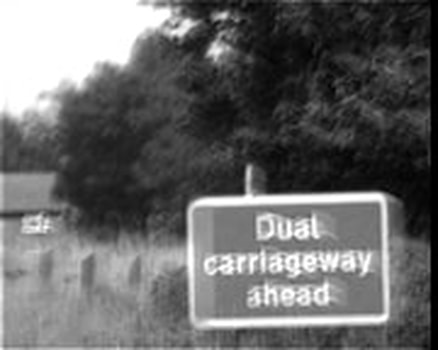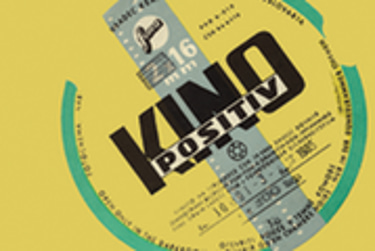

Dear Frank and Dina,
I said that I would tell you about the new film. A camera sits inside a yellow Mini, fixed to a tripod wedged between the front and rear seats. The magazine, loaded with Ilford monochrome negative film, is attached to the top of the camera, stabilizing it by pressing against the car roof. The camera lens, made in France , is altered to a suitable focal length to frame the rear view mirror of the car in such a way that the lower grey plastic edge of the mirror's mount splits the field of view horizontally. Above this dividing line - which is out of focus due to the proximity of the camera - is the image reflected by the mirror, whilst below is the image viewed through the car's windscreen. By turning the outer ring on the lens mount to the hieroglyph understood to represent infinity, both of these image components are hauled into focus. The car motor is started and the vehicle moves off, a little tentatively at first due to some uncertainty as to the stability of the camera supporting structure. Upon reaching the Nottingham ring road, the car turns left and the camera motor is started. It runs at the speed of 25 frames every second. After 7½ minutes have elapsed, and 300 feet or 11,250 frames of film have passed through the gate of the camera, the camera motor is stopped. The magazine is removed after the film inside the camera has been unlaced from the transport mechanism. The magazine is marked on side with the words 'Rear View’ in white chinagraph pencil.
An identical magazine containing a fresh 400 foot roll of film is attached to the camera, which is lowered and the lens directed out of the windscreen of the car. The focal length of the lens is adjusted to enclose the sweep of the windscreen wiper on the passenger side of the car, but remains focused on infinity. The vehicle resumes its journey and the camera motor is started. The car’s windscreen wipers are operated, whilst the camera motor is running. Again the camera motor is stopped after 7½ minutes have elapsed, 300 feet or 11,250 frames of film having passed through the camera gate. The magazine is removed. lt is marked with the word 'Wiper', using the same white chinagraph pencil.
A third magazine, containing a third 400 foot roll of film of similar emulsion, is attached to the top of the camera. The camera is moved to the extreme right hand side, or off-side, of the car. The lens is directed towards the driver's wing mirror. The focal length is altered in such a way that the area of the reflected image and that of the surrounding image are approximately equal. The latter is probably a little larger. The lens remains focused, infinitely, on infinity. The rim of the mirror mount is rendered unsharp. The vehicle moves off, and a few seconds later the camera motor is started. 7½ minutes elapse. 300 feet or 11,250 frames of film pass through the camera gate. The camera motor is stopped, the magazine detached and marked with the words ‘Wing Mirror'. Six and a half hours later it is dark. Each of the three processes is repeated, in each case lacing up the camera with the film in the appropriate magazine. The film remaining in each magazine is run through the camera gate until it runs off the feed core in the magazine and all 400 feet of exposed film are located on the take-up core. The duration of each of these sequences is 2½ minutes. 100 feet or 3,750 frames of film pass through the camera gate.
The exposed rolls of film are removed from the magazines, being placed first into black paper bags and then into their accompanying tins. Each tin is securely taped, the taped tins being further wrapped in corrugated cardboard and brown paper, and the parcel is addressed and posted to Filmatic Laboratories Ltd, 16, Colville Road , London W11 2BS .
What do the subjects feel buried in a layer of gelatin in the darkness?
There is no known way to detect a latent image in a photographic emulsion except by the process of development. Out of the chemicals and into the light emerge patterns of minute particles of varying densities of black - producing tones of grey. This film is sandwiched with an unexposed piece of film and passed before a light. After undergoing an identical chemical process of development the latter film exhibits tones having the reverse intensities of those of the camera film.
Five days elapse whilst this is performed. Five days, before the film-maker receives both original negative film and the accompanying 'print’, as the copy is called. Each is wound separately onto yellow plastic cores, 3 inches in diameter. The tin containing the negative is labelled ‘Dual Carriageway-Negative’ and placed in a cupboard containing similar tins of various diameters. The positive print, on its core, is located on a spool which splits laterally to accommodate the core and the roll of film. The spool is locked and mounted on the feed arm of a projector. The film is laced around the transport mechanism and through the gate of the projector. It is finally secured to the rear, or take-up spool. The projector motor is started and the lamp switched on. The film travels through the gate of the projector. An image appears on the screen in the path of the light beam. The show has begun.
